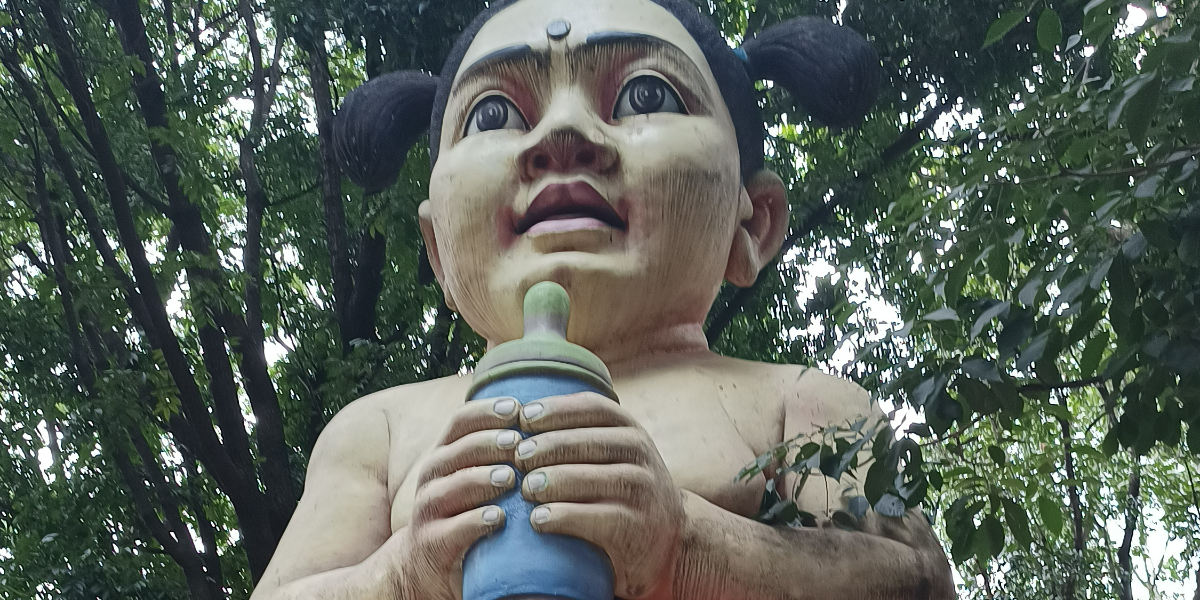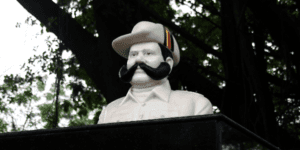Artist Ravi Kashi, along with researchers Madhuri Rao and Salila Vanka, interprets monuments and sculptures with the changing socio-eco landscape of Bengaluru.

Statue of child with milk bottle at Ranadheera Kanteerava park. (Supplied)
Bengaluru folks, how often have we walked past the statues of BR Ambedkar, late veteran actor Rajkumar, and warrior queen Kittur Rani Chennamma, and just glanced at them without actually noticing them?
Often, iconic landmarks only serve as visual waypoints to navigate through the city. At other times, they surface in our memories and conversations. But they are much more than that, says artist Ravi Kashi, who embarked on a journey to rediscover them, along with urban researchers Salila Vanka and Madhuri Rao, last year.
One year later, the trio has documented 700 sculptures that include statues of public figures, creative sculptures by professional artists, and some popular examples of public art.
This documentation emerged from a research project titled “Narratives of Visual Culture and Spatial Politics: A Study of Public Statues and Sculptures in post-1990s Bengaluru”, for the India Foundation for the Arts (IFA) under the Project 560 programme, and it resulted in an exhibition “On a Pedestal”, held in the city last month.
The impact was profound as all the imagery came together in the Belaku Gallery.
“We never expected to find more than 250-300 statues, but we ended up spotting 700, which was surprising,” says Kashi.
The presence of these characters, according to Kashi, who uses a variety of media including painting, sculpture, photography, and installation, communicates a great deal about the city’s history, demography, and culture.
“Public statues and sculptures in a city are static markers of urban culture and development. They are also dynamic symbols of local (and national) identity and power struggles. Public statues occupy not just material space, but they also occupy the psyche of city publics as symbols of identity, presence, and control,” states the project statement.
These sculptures represent Bengaluru’s shift, as IT businesses started to move into the city in the 1990s.
Even though there is little interaction from the general public with these figures, their installation and very existence could be regarded as having significance and relevance.
Kashi informs that their research proved that the majority of sculptures are located in the city centre and not in the new suburbs of the city.
“They are indicative of cultural anxiety, identity, and vote-bank politics, through the lens of proliferation, location, materiality, and thematic subjects,” notes Madhuri Rao, who teaches at RV College of Architecture.
Dividing the public statues and sculptures into realistic statues, creative sculptures by professional artists, and popular public art sculptures, the three fanned out into the western, southern, and eastern parts of the city.
“While I looked at the western part, Salila and Madhuri took care of the south and east, whereas all of us covered the city centre. We also requested friends and the public to send information about them and we also found some through Google,” shares Kashi.
“During documentation, we also noted down their surroundings, the material used and who made it, whether it was made by a fan association or the government. If they are on a pedestal, we observed the height of the pedestal, canopy, etc,” explains Kashi.
About a hundred of the statues that the researchers discovered were of actor Rajkumar. Known as ‘Annavaru’ (as Rajkumar is known in Karnataka), Rajkumar became identified with the Kannada language, identity, pride or asmite (self-respect), after participating in the renowned Gokak Agitation in the 1980s.
The Gokak Agitation aimed to make Kannada the default language in schools after rejecting Sanskrit as the first language in high schools. Ergo, it is natural to find his busts and statues scattered across the city, given his illustrious reputation.
“Multiple statues of his have been simply replicated. We visited the studios of two well-known sculptors, Chalapathi and Shivakumar and found their studios to be full of moulds of well-known actors like Rajkumar, Vishnuvardhan, Ambareesh, and Puneeth Rajkumar. The fans would just want a statue or a bust of their favourite actor to be installed somewhere without any creative additions. Ninety percent of film statues have been done by Shivakumar,” reveals Kashi.
Another intriguing feature of Rajkumar’s sculptures, according to the artist, is that while most of them show the actor in well-known roles that he has played, a few depict Rajkumar as he actually was. Most of these sculptures happen to be just busts rendered in fibre glass as it works out to be a cheaper option, shares Kashi.
The group also managed to capture the statue depicting Rajkumar as Raja Harishchandra from the 1965 movie Satya Harishchandra at Harishchandra Ghat in Rajaji Nagar.
Besides Rajkumar, the team found 50 statues of Ambedkar in the city.
“Srirampuram is an area that is filled with cotton mills and is known to be a labour-supplying area. Every second and third road has a sculpture of Ambedkar. You often find his statues in EWS societies. It’s not just to assert their identity but also to protect themselves. Once the Ambedkar statue comes up, it’s not easy to demolish even an illegal structure,” notes Kashi.
Since the time Kempe Gowda’s folded-hands statue in Shivagange, Karnataka, was erected in front of the deity, his subsequent sculptures exhibit him in a different posture.
According to Kashi, the growing number of his statues (around 17 as of now) and that he is depicted with a sword could be an attempt to appeal to a particular demographic and changing socio-political landscape.
The team also came across sculptures of late Major Sandeep Unnikrishnan (who died during Mumbai terrorist attacks in 2008), late traffic cop Meese Thimmaiah (Marichikaiah Thimmaiah), who died while trying to save a mother and child from a speeding vehicle, Basavanna (lingayat saint-poet), Kanaka Dasa (mascot of the Kuruba community) and Saint Valmiki.
In Ashok Nagar, which is dominated by Tamilians, researchers found statues of Brazilian footballer Pelé, Mother Teresa, and Ambedkar.
“All three are at a single junction in the area. Football is popular among Tamilians, so you find Pelé, and there is a large section of Christians and Dalits in the area, which explains the presence of Mother Teresa and Ambedkar,” reports Kashi.
The researchers found just 12 statues of women, which included Kittur Rani Chennamma, Parvathama Rajkumar (veteran film producer and wife of late actor Rajkumar), and a bronze statue of Rani Abbakka Chowta, considered the first female freedom fighter. “It shows the patriarchal mindset,” says Kashi.
Talking about challenges encountered during the process, Salila, who teaches urban social theory and conducts architecture and urban design studios in RV College of Architecture, Bengaluru, says, “One of the goals of our research was to identify and give due credit to the artists and sculptors who had contributed to the city’s public realm in the form of the statues and sculptures.”

Bust of head constable Marichikaiah Thimmaiah, fondly known as Meese Thimmaiah, in front of GPO. (Ravi Kashi)
“We discovered very few instances where the maker’s name was seen on or around the statue, making it challenging for us to achieve our goal of bringing the anonymous artists and makers to the fore,” notes Salila.
These little differences in their themes, appearances, and postures reveal numerous strata of the metropolis. They are all, in a sense, starting points for understanding the vitality that distinguishes the city, which is today known as India’s IT hub.

Jul 26, 2024

Jul 26, 2024

Jul 26, 2024

Jul 26, 2024

Jul 26, 2024

Jul 25, 2024